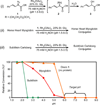Chemoselective tryptophan labeling with rhodium carbenoids at mild pH
- PMID: 19366262
- PMCID: PMC2722835
- DOI: 10.1021/ja900094h
Chemoselective tryptophan labeling with rhodium carbenoids at mild pH
Abstract
Significant improvements have been made to a previously reported tryptophan modification method using rhodium carbenoids in aqueous solution, allowing the reaction to proceed at pH 6-7. This technique is based on the discovery that N-(tert-butyl)hydroxylamine promotes indole modification with rhodium carbenoids over a broad pH range (2-7). This methodology was demonstrated on peptide and protein substrates, generally yielding 40-60% conversion with excellent tryptophan chemoselectivity. The solvent accessibility of the indole side chains was found to be a key factor in successful carbenoid addition, as demonstrated by conducting the reaction at temperatures high enough to cause thermal denaturation of the protein substrate. Progress toward the expression of proteins bearing solvent accessible tryptophan residues as reactive handles for modification with rhodium carbenoids is also reported.
Figures











Similar articles
-
Selective tryptophan modification with rhodium carbenoids in aqueous solution.J Am Chem Soc. 2004 Aug 25;126(33):10256-7. doi: 10.1021/ja047272c. J Am Chem Soc. 2004. PMID: 15315433
-
Intermolecular reactions of electron-rich heterocycles with copper and rhodium carbenoids.Chem Soc Rev. 2007 Jul;36(7):1109-19. doi: 10.1039/b607983k. Epub 2007 Feb 15. Chem Soc Rev. 2007. PMID: 17576478 Review.
-
Silica-immobilized chiral dirhodium(II) catalyst for enantioselective carbenoid reactions.Org Lett. 2013 Dec 20;15(24):6136-9. doi: 10.1021/ol403006r. Epub 2013 Nov 19. Org Lett. 2013. PMID: 24251986
-
Domino [4 + 1]-annulation of α,β-unsaturated δ-amino esters with Rh(II)-carbenoids – a new approach towards multi-functionalized N-aryl pyrrolidines.Org Biomol Chem. 2015 Mar 7;13(9):2640-51. doi: 10.1039/c4ob02454k. Org Biomol Chem. 2015. PMID: 25582707
-
Domino reactions of rhodium(II) carbenoids for alkaloid synthesis.Chem Soc Rev. 2009 Nov;38(11):3072-81. doi: 10.1039/b816701j. Epub 2009 Apr 3. Chem Soc Rev. 2009. PMID: 19847342 Review.
Cited by
-
Product-oriented chemical surface modification of a levansucrase (SacB) via an ene-type reaction.Chem Sci. 2018 May 22;9(24):5312-5321. doi: 10.1039/c8sc01244j. eCollection 2018 Jun 28. Chem Sci. 2018. PMID: 30009003 Free PMC article.
-
Synthesis of Peptoids Containing Multiple Nhtrp and Ntrp Residues: A Comparative Study of Resin, Cleavage Conditions and Submonomer Protection.Front Chem. 2020 Apr 29;8:370. doi: 10.3389/fchem.2020.00370. eCollection 2020. Front Chem. 2020. PMID: 32411678 Free PMC article.
-
Residue-Specific Peptide Modification: A Chemist's Guide.Biochemistry. 2017 Aug 1;56(30):3863-3873. doi: 10.1021/acs.biochem.7b00536. Epub 2017 Jul 17. Biochemistry. 2017. PMID: 28653834 Free PMC article. Review.
-
Recent Advances in Bioorthogonal Ligation and Bioconjugation.Top Curr Chem (Cham). 2023 Nov 22;381(6):35. doi: 10.1007/s41061-023-00445-6. Top Curr Chem (Cham). 2023. PMID: 37991570 Free PMC article. Review.
-
Regioselective rapid ene-type reaction (RRER) enables bioconjugation of histone serotonylation.RSC Chem Biol. 2025 Jul 17;6(8):1278-1283. doi: 10.1039/d5cb00159e. eCollection 2025 Jul 30. RSC Chem Biol. 2025. PMID: 40704109 Free PMC article.
References
-
- Hermanson GT. Bioconjugate Techniques. 1 ed. San Diego: Academic Press; 1996.
-
- Tilley SD, Joshi NS, Francis MB. Chemistry and Chemical Reactivity of Proteins. In: Begley TP, editor. Wiley Encyclopedia of Chemical Biology. Hoboken, NJ: Wiley; 2008. in press.
-
- Koshland DE, Karkhanis YD, Latham HG. J. Am. Chem. Soc. 1964;86:1448–1450.
-
- Savige WE, Fontana A. Methods in Enzymology. 1977;47:442–453. - PubMed
-
- Antos JM, Francis MB. J. Am. Chem. Soc. 2004;126:10256–10257. - PubMed
Publication types
MeSH terms
Substances
Grants and funding
LinkOut - more resources
Full Text Sources
Other Literature Sources

